#BA2a: Mythological Bestiary
Photo
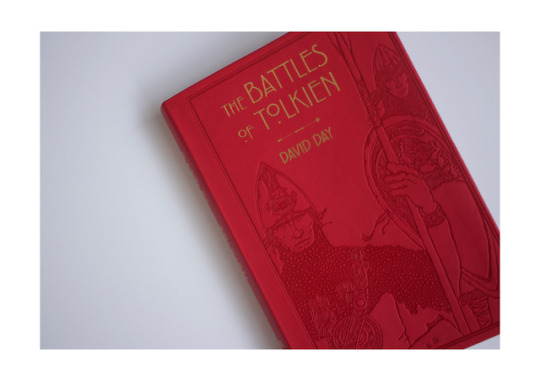
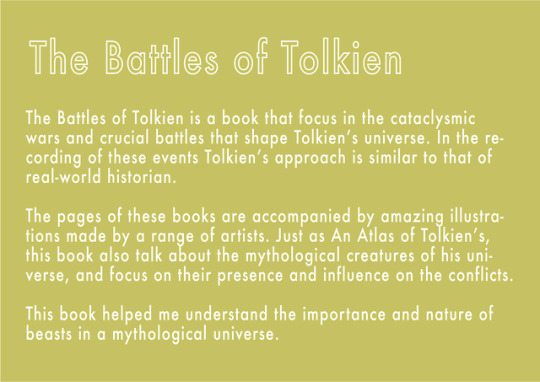

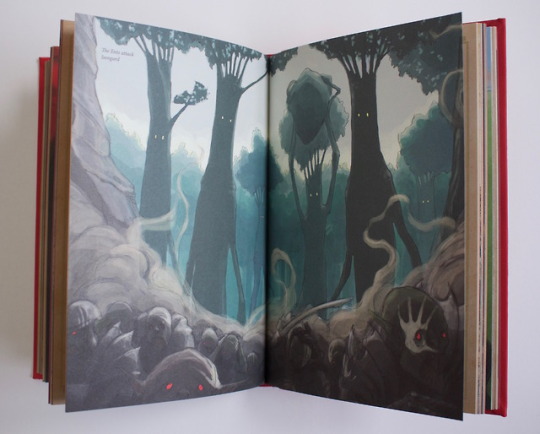



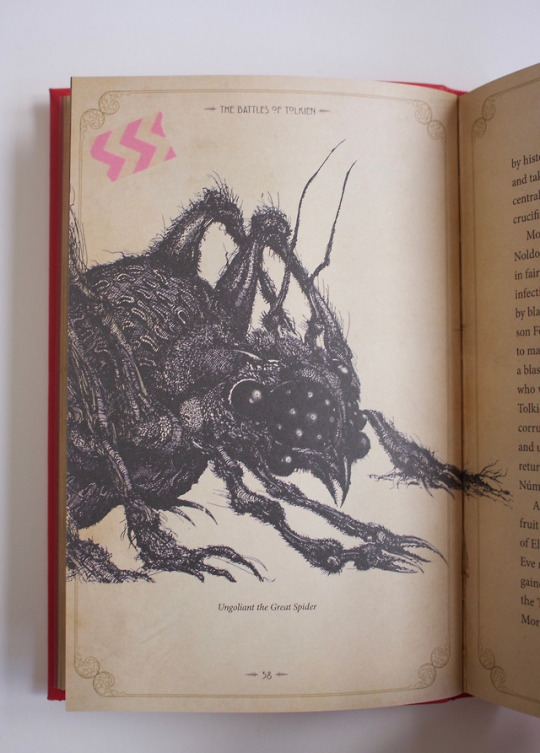
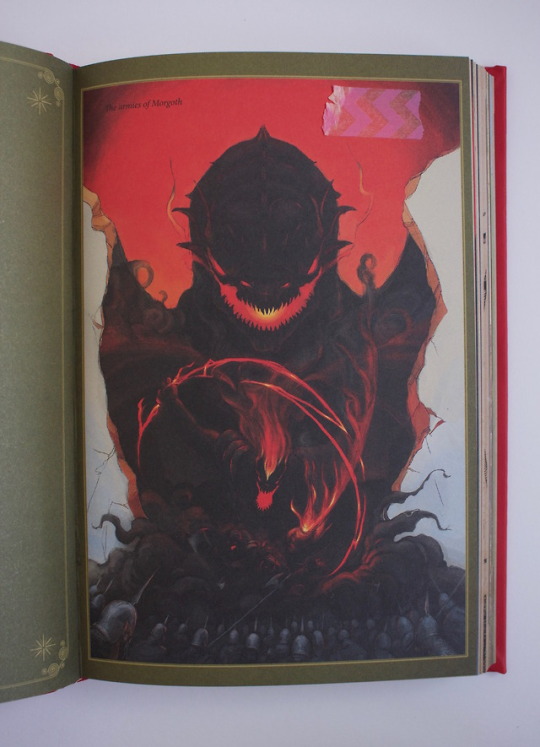

Day, D. (2016). The Batlles of Tolkien.
60 notes
·
View notes
Photo
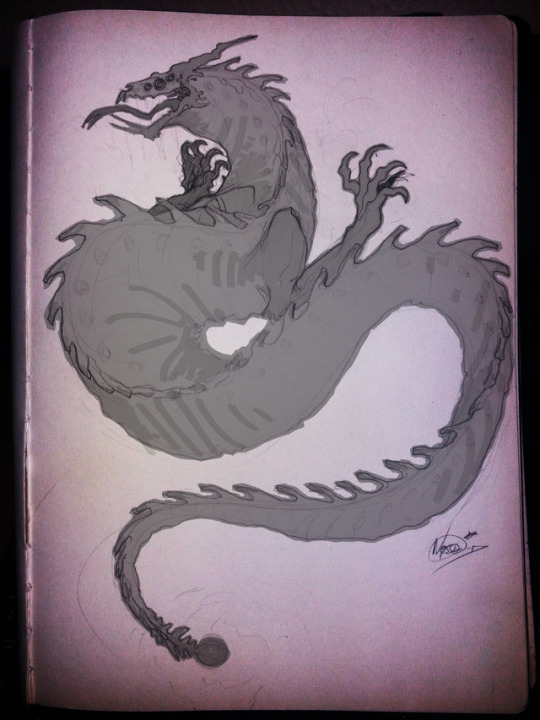

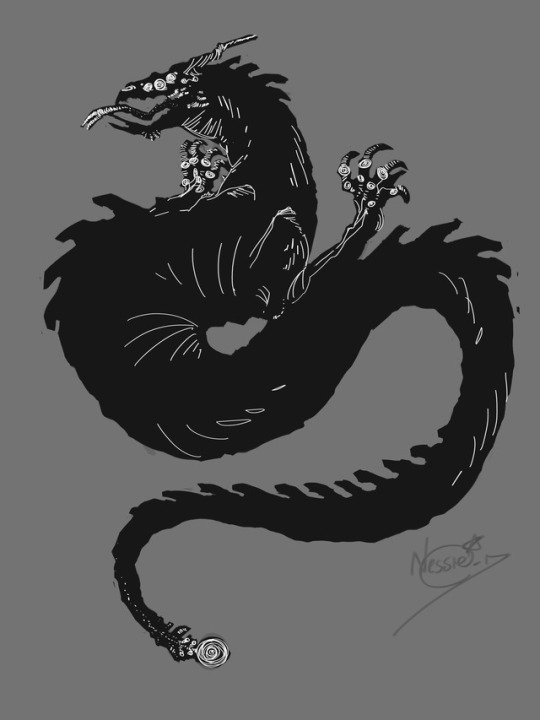
Yet another design for the Bestiary monster!
I really like this one, the silhouette especially! Nice and defined.
I’ll do some more tweaking, maybe with the head and arms, but I reckon this is gonna be mostly what my creature looks like.
I need to try and figure out what background I’m going to have the monster in!
And maybe a name.
2 notes
·
View notes
Video
BA2a: Mythological Bestiary - Character Development Reel - 16.02.2018
0 notes
Text
Weekly Review 9 (11/02/19)
In the final week of our BA2a Unit, I finished the two remaining projects that we have to complete for submission, and produced Experimentation Reels for both.
Mythological Bestiary:
I spent the majority of my time in the Mythological Bestiary project this week focusing solely on completing the two outstanding animation sequences, from the blocking stage all the way to the final render. Beginning by blocking both animations, I used the previously made animatics as reference for the timings initially, but very quickly adjusted these when I found that they did not translate well into the blocking stage. While the third animation had no real problems at all at this stage, I did struggle slightly to rotate the character’s body around the tree in the second animation, due to the complicated way that my rig is built. Once I had blocked both, I moved on to conducting a spline pass, which again resulted in few problems for the third animation, but again caused issue with the character’s rotation in the second, resulting in me having to reposition the visible hand and leg so that the former would remain still throughout the motion, while the latter would move upwards, to suggest it was being used to step around the tree. Following this, I added anticipation and follow through to both animations, as well as some secondary action, which involved the character’s head turning side to side in the second animation, and its body bobbing up and down slightly as it backed away in the third.
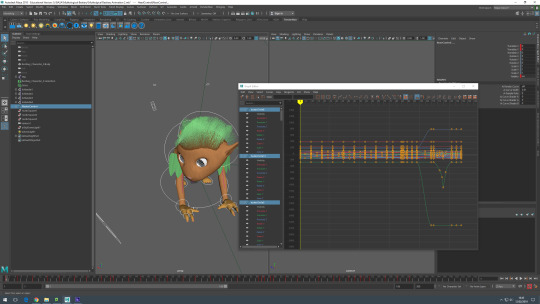
With the animation itself completed, I then prepared to render both. While the use of the Physical Sky light worked perfectly in the third animation, I found that it left a translucent white bar along the top of the shot in the second. This forced me to use an Area Light instead, which needed to be set to 600000 intensity in order to have the correct lighting effect on the character. After setting lighting to both animations, I rendered the two out in different ways: while the second animation was rendered out with a standard batch render, I rendered the third on two separate render layers; one with only the character as it normally appeared, and another that acted as an ambient occlusion layer, with a plane underneath the character and the Physical Sky light, to create the shadow. This was to create the shadow effect under the character, which was more noticeably absent in this sequence. Once both had been rendered out, I put them in an After Effects composition with the background image, and rendered out the resulting sequence.

The final touch of these animations was to add sound, which I did by reusing the majority of the sounds I used in the first animation, with the addition of the Water River 2 sound in the second animation, and the Arrow Impact Wood sound to create the sound of breaking sticks in both.
With the last of my animations fully complete, all that remained was to produce the Experimentation Reel, to showcase the production process for the project. I began by showcasing the pre-production work that I made, beginning with the initial designs for the character, and showing its evolution into the textured 3D model in Maya. I then showed each of the three animations sequentially, beginning with the animatic stage, and showing how these iterated into fully rendered sequences.

To summarise, I am incredibly proud with the work I have produced on the Mythological Bestiary project this week and as a whole, and while I feel as if my animations could have been slightly better if I had allowed myself more time, I think they show a marked improvement in my development as an animator, in particular due to my inclusion of sound design and capacity for making the rig myself.
Character Performance:
As I had already finished and rendered my Character Performance animation last week, all that I had to do this week was complete an Experimentation Reel for the project. Given the experience that I have with producing these kinds of showreels, I was fairly confident in my approach to this task. Beginning with the pre-production phase of the animation, I showed the animatic that formed the basis of the entire production process, before moving on to the iterative development of the animation itself. I showed how I began with the lip sync and facial expressions of the animation, then added a second character and a set to the scene, after which I blocked, splined, and refined poses across the two, culminating in the final rendered version of my animation. While the audio playing for every iteration is slightly repetitive, I am happy with the result, as it showcases the degree of work and time that I put into this animation. Although I do wish that my laptop’s version of Premiere Pro was capable of more interesting title cards.
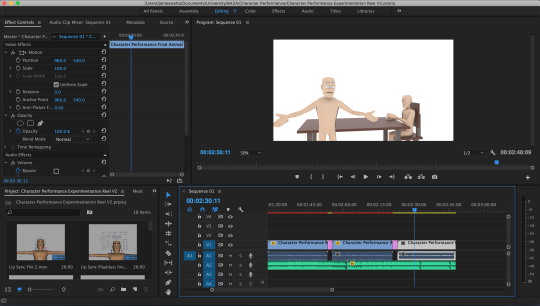
0 notes
Text
Weekly Summary (19.02-23.02)
Here come a work. I wish I could elaborate of nice snowing days, however I was busy with animation. I was working on mythological bestiary project and writing an essay.
Mythological Bestiary was a fun project... before missing work of two month. I had to draw my character in TV paint and also I wanted to do a stop motion animation. At home I was working on a puppet, while in university I spent all day in the media lab drawing the 2d animation of my character. The first part took my all week, with the line art and colouring. As for the lip sync, I was working on a complicated background and adding to much details, when I would do something simpler. However I did not realised it yet. I was really hating myself for missing all the lectures on after effects, but there nothing I could do.
Narration project was coming quite well. I was happy with the outcome, even though I could come up with the synopsis due to the limitation of words.
0 notes
Text
Week 17 Summary
Mytholgical Bestiary
This week I finished the visuals of both Mythological beast animations and added in the sound effects! I love the final outcomes, I think I successfully illustrated the eerie atmosphere I was going for. I was to improve this I think I would’ve animated the creature doing more, climbing up a tree and walking around stalking prey. This would’ve showcased the movement much better. I also would have liked to add some video effects, maybe some video static and glitches to make the video perhaps look like it’s coming from a camera that was set up in the woods to document the beast or a security camera.
Narrative strategies
After finishing both my story and essay I’m pleased with the result, it took a few drafts for me to be happy with my story but I think i’ve made an interesting piece of text that reflects some of the ideas on duality and human condition presented in The Strange Case of Dr Jekyll and Mr Hyde. I think if i would change anything I’d try a story that was more heavily inspired by the source material. I took the inspiration quite loosely so it would have been interesting focusing more in the idea of split personality in a literal sense and maybe incorporating some of the quotes from the novel.
Character performance
This week I finished my lip sync video for this project. I’m pretty pleased with the result and am pleased I added things such as the close up shot and explosion since it makes for a much more entertaining animation. The colours I chose in the end were quite subtle since I didn’t want to distract from the conversation.
0 notes
Text
Experiment
youtube
The model is a project of an Interior Desing student, Leonor Peixoto (www.leonorpeixoto.com) and the idea was to do a small piece of footage to show the model in different angles. This is the attempt the first attempt of the idea I had to present the model in plasticine.
1 note
·
View note
Text
BESTIARY - Monsters
22/11/17
THE GREEKS
“Greek myth attempts to explain the origins of the world, and details the lives and adventures of a wide variety of gods, goddesses, heroes, heroines and mythological creatures. These accounts initially were disseminated in an oral-poetic tradition; today the Greek myths are known primarily from ancient Greek literature. The oldest known Greek literary sources, Homer’s epic poems Iliad and Odyssey, focus on the Trojan War and its aftermath. Two poems by Homer’s near contemporary Hesiod, the Theogony and the Works and Days, contain accounts of the genesis of the world, the succession of divine rulers, the succession of human ages, the origin of human woes, and the origin of sacrificial practices. Myths are also preserved in the Homeric Hymns, in fragments of epic poems of the Epic Cycle, in lyric poems, in the works of the tragedians and comedians of the fifth century BC, in writings of scholars and poets of the Hellenistic Age, and in texts from the time of the Roman Empire by writers such as Plutarch and Pausanias.” - Wikipedia
CHILDREN OF TYPHON
Typhon was the last son of Gaia and Tartarus, and known as “The Father of All Monsters”. There are several different versions of what he looked like, but most of them depict him with either his head and/or arms and legs replaced by 100s of snake and dragon heads, with 100s of different wings, with red eyes that terrified anyone who looked into them and a “savage jaw” that could breathe fire.
Typhon married Echidna, who was described as having the top half of a beautiful woman but the bottom half of a huge and terrible snake - she became known as “The Mother of All Monsters”.
The couple went on to raise some of the most famous monsters from Greek mythology;
SPHINX
With the body of a lion, the head of a woman and occasionally the wings of a bird, the Ancient Greek Sphinx was a treacherous beast that killed and devoured anyone who couldn’t answer her riddles.
She was defeated by Oedipus when he answered correctly, the monster throwing herself into the ocean in a fit of rage/despair and drowning.
NEMEAN LION
A giant lion with impenetrable skin and claws that could shred any armour, this beast was slain by Hercules as part of his Twelve Labours, as a result freeing the city of Nemea in the Peloponnesus.
The Lion was said to have become the constellation Leo after being slain.
CERBERUS
Cerberus was the giant three-headed hellhound that guarded the gates of Hades, fawning over those who entered Hades’ House and ensuring no-one left - eating those who attempted to. He was sometimes depicted as having a serpent for a tail and snakes protruding from his body.
Hercules managed to capture Cerberus, shooting Hades in the process, and presented him to Eurystheus, completing his twelfth Labour.
Cerberus was then either returned to Hades by Hercules, or was said to have escaped and returned by himself.
LADON
The serpentine dragon that guarded the Golden Apples in the Garden of the Hesperides, curling around the roots of the Apple Tree.
The dragon was sometimes depicted with a hundred heads, each speaking a different language.
Ladon was defeated by Hercules as another of his Labours, but whether the dragon was killed or not varies on the author.
LERNAEN HYDRA
A water-dwelling serpent-like monster with many heads, the Lernaen Hydra’s lair was in the lake Lerna at Argolid, said to be the entrance to the Underworld and the same location of the myth of the Danaids.
The hydra’s breath was poisonous, and its blood was so vitreous that even the scent of it was deadly. It was was also said to regenerate its heads - when cut, two more grow back, until the neck stumps were burned with fire.
Hercules managed to slay the Hydra for his second Labour.
CHIMERA
A monstrous beast with the head and half-body of a lion, the head (and back-legs) of a goat and the tail and head of a snake, the Chimera was a bad omen, and said to be seen before shipwrecks, storms and other natural disasters - such as volcanoes.
It was a “she”, and the goat head could breathe fire, with the snake head having venomous fangs.
She was slain by Bellerophon and Pegasus.
OTHER MONSTERS
ARACHNE
A human woman skilled at weaving, Arachne boasted so much about her skill that she (depending on the author) either challenged the Goddess Athena to a weaving contest, or Athena became so annoyed at her boasting that she challenged the mortal herself.
Athena wove four stories depicting mortals striving for godhood and facing the consequences, whilst Arachne wove four stories of the Gods punishing mortals for no reason; Arachne’s stories painted the Gods in a bad light, and her weaving was a much better quality than Athena’s, causing the Goddess to become both enraged and embarrassed.
There are a few different endings - some where Athena curses Arachne, turning her into a spider; others where the curse means that Arachne can’t weave with any loom or tool ever again, the woman becoming so distraught that Athena eventually takes pity on her and turns her into a spider so that she can continue with what she loves without breaking the curse; and a few versions where - after seeing the error of her ways and how arrogant she was for mocking the Goddess to give her the skill of weaving in the first place - Arachne takes her own life, Athena then bringing her back as a spider so that she can continue doing what she loves.
Regardless of which ending is used, Arachne’s fate remains the same, and stands as the origin of the words “arachnid” and “arachnophobia” - it was also a story the Ancient Greeks used to explain why spiders create the webs to hunt and live on.
CENTAURS
As followers of Dionysus: god of wine, insanity and parties, the half-horse-half-man Centaurs are typically boisterous, barbarian beasts that represent chaos and the unruly effects of consuming alcohol.
One centaur, however, was much wiser and more civilised than his kinsmen: Chiron, son of Philyra and Cronus, was the tutor to the likes of Achilles, Hercules and Jason, and resided in the forests of Mt. Pelion with his wife Chariklo, a nymph.
CYCLOPES
One-eyed giants that are said to be the sons of Poseidon and Gaia or nymphs, the often savage beasts are workmen of Hephaestus’s forge due to their resistance to heat and their ability to smith.
A famous Cyclops is Polyphemus, born by the nymph Thoosa and the god Poseidon, described in Homer’s Odyssey as the giant that was blinded by Odysseus, who tricked him into believing he was attacked by “nobody” after he and his crew were taken and some eaten by the cyclops.
HARPIES
Harpies, with the bodies of birds and the faces of women, are often regarded as the hounds of Zeus due to them being dispatched to snatch people and objects from Earth, or to deliver punishment, for the god - being used to explain sudden or mysterious disappearances.
MEDUSA
Medusa was the mortal of the three Gorgons - sisters with hair of snakes and grotesque faces.
She was a beautiful woman before she cursed by Athena after falling in love with Poseidon and breaking her priestess vows, or after fleeing to her temple to hide from the god (depending on the author); turning her eyes red, her skin green and her hair into a mass of venomous snakes - anyone who looked at her directly turned into stone.
Legend has it that Medusa travelled Africa for a time, baby snakes dropping from her head as she walked - explaining why there are so many snakes on the continent.
She was slain by Perseus, the man using a polished shield from Athena to watch the Gorgon’s reflection so as not to be turned to stone.
MINOTAUR
Born to the wicked King Minos as a mutated, half-bull looking creature, the Minotaur was sealed in a Labyrinth under Crete, built by the inventor Daedalus, after Minos killed the mother and couldn’t stand to see it as his son.
Anyone with qualms against the King were sent there to be eaten by the beast - Theseus being one of them.
However, the man had plotted with Minos’s beautiful daughter, Ariadne, and took with him a ball of yarn and a sword she had given him, the first so that he would be able to find his way out of the ever shifting and confusing maze, and the latter to kill the Minotaur.
SIRENS
Another monster that was part woman, part bird, Sirens would draw sailors to their deaths with their beautiful singing.
Two heroes were able to survive encountering them: Perseus and Odysseus.
Odysseus has his crew tie him to the mast and plug their ears with bees wax, so that he could listen to the Sirens without jumping overboard.
Perseus had the musician Orpheus, who played music so beautiful it overwhelmed the Sirens’ singing.
It was said that if someone were to escape them, the Sirens would throw themselves into the water and die.
PEGASUS
The son of Poseidon, Pegasus - a brilliant white winged stallion - leapt from the neck of Medusa when she was beheaded by Perseus.
5 notes
·
View notes
Text
BESTIARY - Research
19/11/17
MYTHOLOGY - What is it?
(from the Greek 'mythos' for story-of-the-people, and 'logos' for word or speech, the spoken story of a people)
“A traditional story, especially one concerning the early history of a people or explaining a natural or social phenomenon, and typically involving supernatural beings or events.” - Google dictionary
Myths are stories, usually with a deep symbolic meaning, that are often used to explain natural or unnatural phenomena, such as the weather, the shape of mountains and particular landmarks or features, or to tell how a culture or civilisation began or ended.
They typically involve some sort of supernatural being/event, be that a god or creature, an act of magic, a miracle or a curse.
Myths vary hugely across civilisations and cultures, as a number of factors - including habitat, visual inspiration, cultural relationships and even the mindset/way of life of a civilisation - can affect them. Despite this, however, many myths are curiously similar, in how weather works or how the Earth was created, certain creatures, the different Pantheons, etc - even across civilisations and cultures that never interacted.
“Therefore, even the lover of myth is, in a sense, a philosopher; for myth is composed of wonders.”
- Aristotle (384 - 322 B.C.)
MYTHS, LEGENDS AND FOLKTALES
Myths, Legends and Folktales/lore are often hard to differentiate, and often overlap each other. The main differences are usually how much of the story is based on fact, and how symbolic it is.
Legends tend to be at least partly based upon historical fact, like a certain person or event. They’re semi-true stories with mythical qualities, and often encompass the spiritual beliefs of the culture in which they originate.
Myths are stories based on tradition of or a legend, and usually have deep symbolic meanings. Myths 'convey a truth' to those who tell and hear it, rather than necessarily recording a true event, although some can be re-tellings of an actual event, only shifted in time/place or transformed by symbolic meaning.
They often involve supernatural beings, and - due to the meaning and connection they have with their cultures - can survive for, sometimes, thousands of years.
Folktales are hard to precisely categorise because they often fit into so many, and a popular stories passed on by word of mouth from one generation to the next. The author is usually unknown often many versions of the tale exist.
Folktales include fables, fairy tales, old legends and even 'urban legends', some tales possibly being based on a partial truth that has been lost or hidden over time.
JUNGIAN THEORY OF MYTH
Carl Jung speaks about the psychological truths of myth, claiming that it’s “universal and necessary for the health of the human psyche”, and that we need these stories to make sense of the confusion of our society and own psyches; that myths were an expression of the Collective Unconscious in that they express core ideas that are part of the human species as a whole.
“In other words, myths express wisdom that has been encoded in all humans, perhaps by means of evolution or through some spiritual process. For Jungians, this common origin in the collective unconscious explains why myths from societies at the opposite ends of the earth can be strikingly similar. A Jungian analysis of classical mythology would claim that the main gods and goddesses express archetypes that are common to human thinking everywhere. The main Olympian gods can be seen as expressions of archetypes of different stages of life within the archetypical family. Zeus is the patriarch, Apollo the young man on the cusp of manhood and independence. Hermes expresses the archetypes of the Trickster. Zeus shares some of the features of the archetype of the ‘wise old man’.” - Wikiversity
- The Gods, Goddesses and Heroes embody aspects of cleverness, creativity, aggression, joy, grief, etc.
- The Monsters are actually Monsters of the Mind.
1 note
·
View note
Video
BA2a: Mythological Bestiary - Animated Sequence - Scene 1 - 15.02.2018
0 notes
Video
BA2a: Mythological Bestiary - Maya Animated Sequence - Scene 1 - 14.02.2018
0 notes
Video
BA2a: Mythological Bestiary - Animated Sequence Development Reel - Scene 3 - 13.02.2018
For my run cycle (you guessed it!), I began with the keyframes to establish the key poses seen in a typical run cycle. I then changed the locator's height and keyed it to replicate the bounce in the run. After this, I changed the timing of the animation to test how much speed I wanted the character to possess when running. As mentioned before, the head was a problem, as well as a lot of rocking in the torso, which I kept altering to improve the overall animation.
0 notes
Video
BA2a: Mythological Bestiary - Animated Sequence Development Reel - Scene 2 - 12.02.2018
Treating this animation as the same when I created my first scene, I started with the keyframes in order to gauge how I should pose the character, starting with the legs. Next, I worked on the arms and weight of my monster when he walks. The same problem as before, the jaw controller was deforming my character’s head. I ignored it until I finished my animation, and opened the graph editor and deleted all unnecessary keys in the animation. Referencing I used for this were as followed:

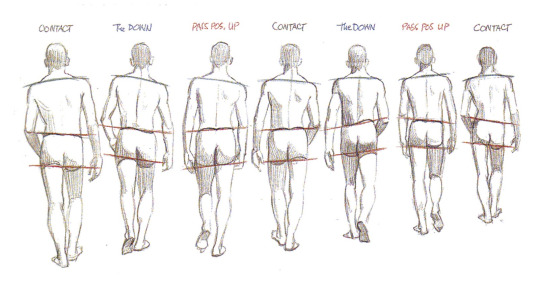
0 notes
Video
BA2a: Mythological Bestiary - Mudbox - 06.02.2018
0 notes
Video
BA2a: Mythological Bestiary - Character Bible - 01.02.2018
0 notes
Video
BA2a: Mythological Bestiary - Character Bible - 01.02.2018
0 notes